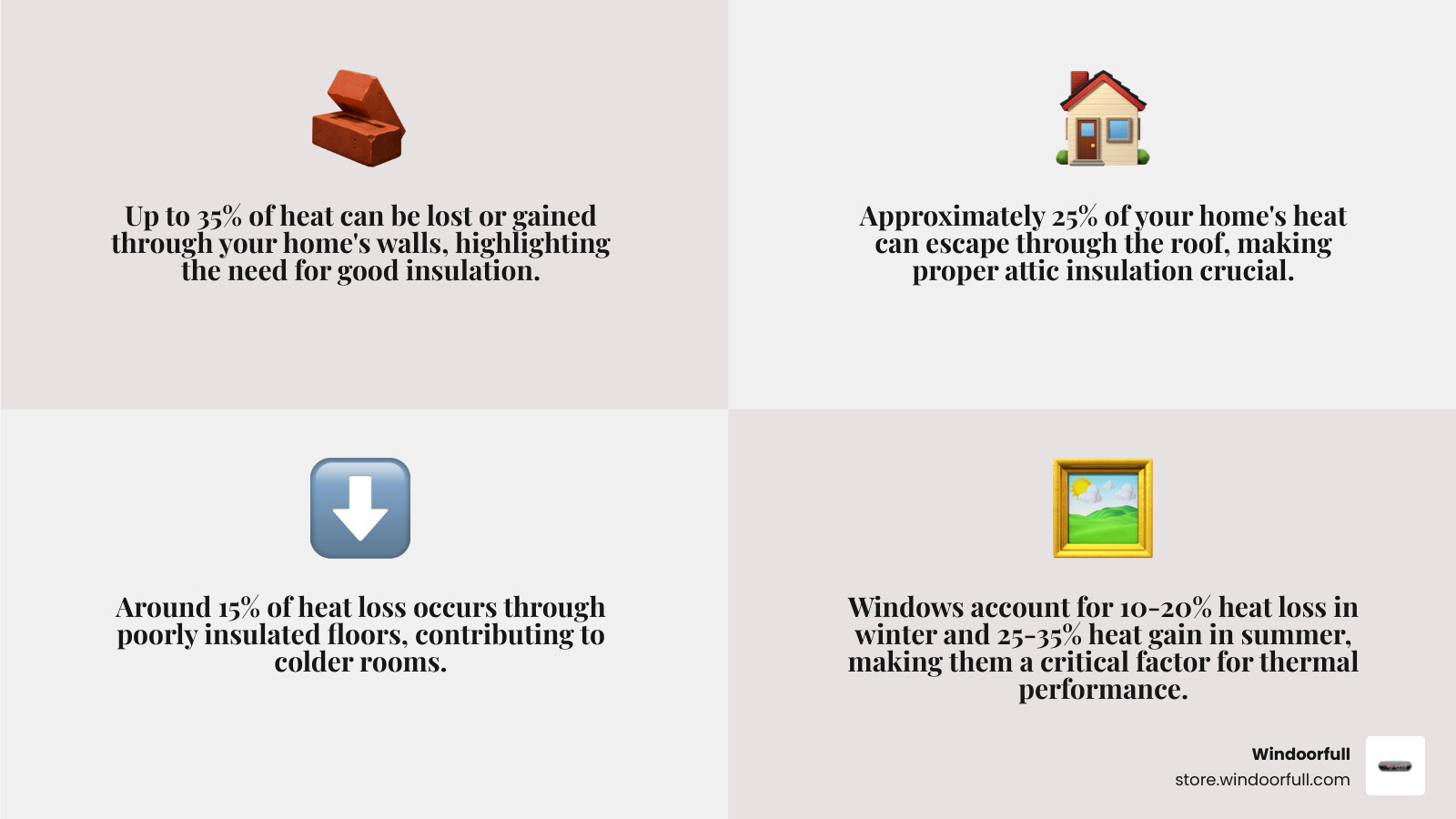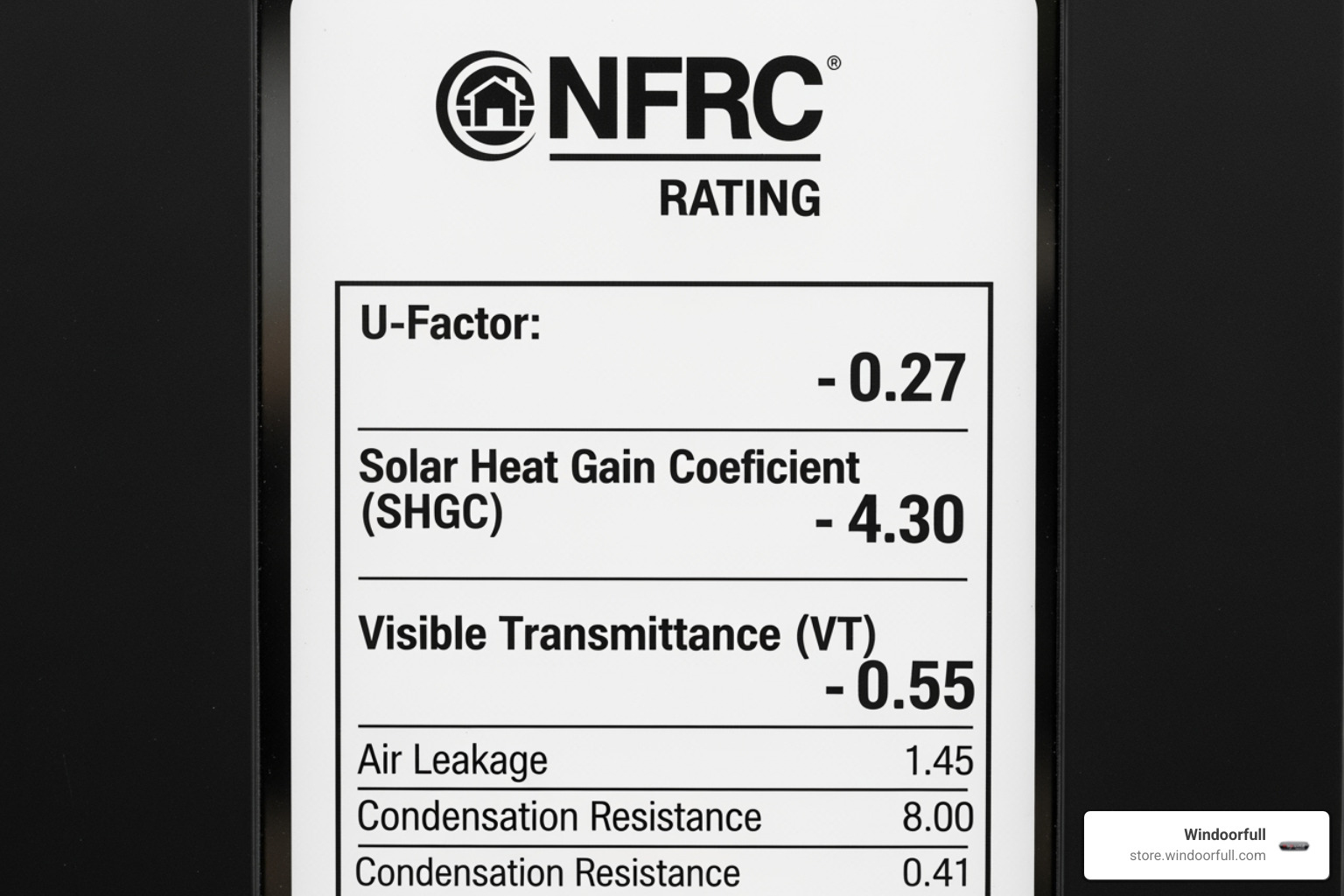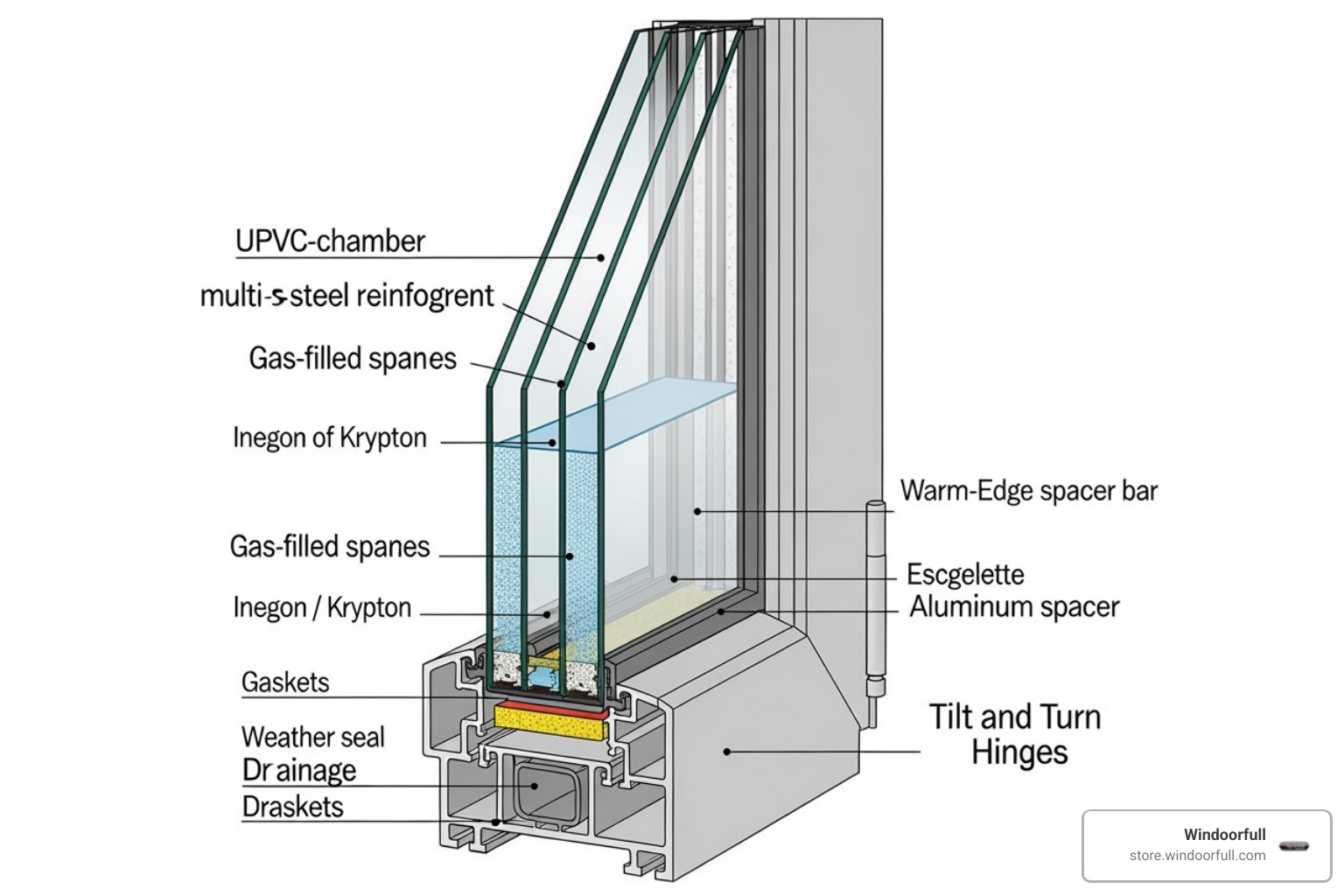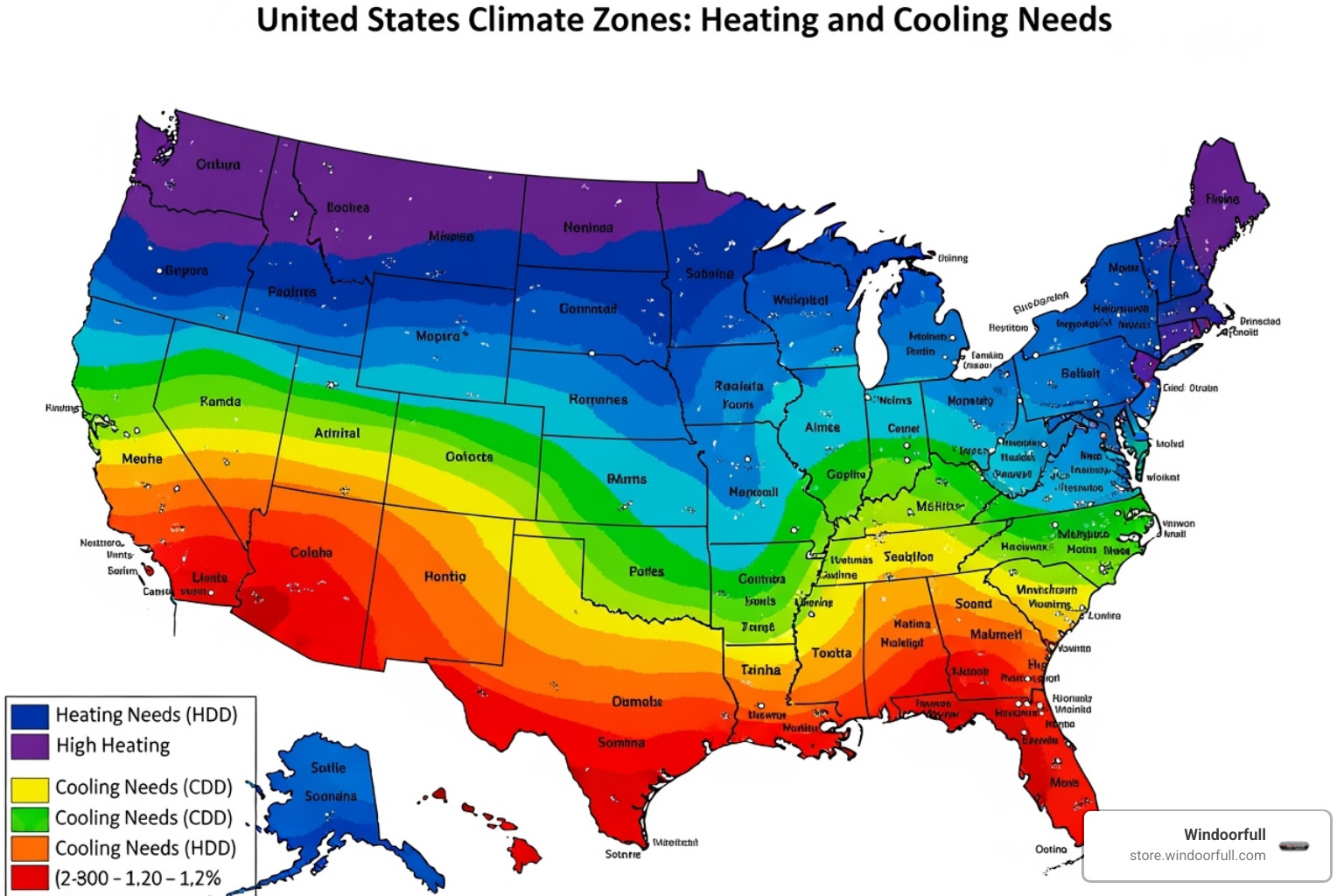
Window Wisdom: Decoding Thermal Performance Ratings
Share
Why Window Thermal Performance Matters More Than You Think
Window thermal performance is a measure of how well your windows prevent heat transfer. Understanding it is key to a comfortable, efficient home.
Key Performance Metrics:
- U-Factor: Measures heat loss (lower is better).
- R-Value: Measures heat resistance (higher is better).
- SHGC: Controls solar heat gain (varies by climate).
- Air Leakage: Prevents drafts (lower is better).
Impact on Your Home:
- Windows cause 25-35% of heat gain in summer.
- Windows cause 10-20% of heat loss in winter.
- High-performance windows can save you up to 45% on energy bills.
With rising energy costs, these ratings are essential for smart investments that boost comfort and savings. Poor window thermal performance leads to cold spots, overworked HVAC systems, and condensation. The right windows act as a thermal barrier, keeping your home comfortable year-round.
We've helped countless homeowners improve their window thermal performance with premium European-style uPVC and aluminum windows. My experience shows how proper thermal ratings translate into real comfort and energy savings.

What is Window Thermal Performance and Why Does It Matter?
Picture your windows as the gatekeepers of your home's comfort. Window thermal performance measures how well they keep heat where you want it. When windows fail, your HVAC system fights a losing battle against the weather.
Heat moves through windows in three ways: conduction (through solid materials), convection (through moving air, like drafts), and radiation (through electromagnetic waves, like sunlight). Poor performance in these areas leads to higher energy bills, a larger carbon footprint, and reduced comfort. High-performing windows combat this by reducing drafts, minimizing condensation, and keeping your indoor temperature steady. It's one of those power of pennies: Simple steps to reduce your energy bills that makes a noticeable difference.
The Financial and Comfort Costs of Poorly Performing Windows
Uncomfortable cold spots in winter and greenhouse-like rooms in summer aren't just annoying—they're expensive. Poorly performing windows can cause 10-20% of a home's heat loss in winter and 25-35% of its heat gain in summer.
Your heating and cooling systems work overtime to compensate, driving up utility bills. Meanwhile, you deal with inconsistent temperatures, condensation that can lead to mold, and UV rays that fade furniture and flooring. Every time your HVAC system runs to counteract heat transfer through your windows, you're paying for energy that isn't making you comfortable.
Understanding the Goal: A Better Building Envelope
Your home's "building envelope"—its walls, roof, foundation, and windows—is a system designed to protect you from the elements. Windows are often the weakest link in this system.
Even with well-insulated walls, mediocre windows can sabotage the entire envelope by lowering the effective R-value of your wall assembly. This makes your insulation less effective than it should be.
The good news is that high-performance windows can flip this script. Instead of being a weak point, they strengthen your home's overall insulation. Your HVAC system gets a break, your indoor environment stays more stable, and you finally get the comfort you deserve.
The Language of Efficiency: Decoding Key Performance Metrics
Shopping for windows can feel like decoding a foreign language with acronyms like NFRC and numbers like 0.30 U-factor. Thankfully, these standardized ratings from organizations like the National Fenestration Rating Council (NFRC) exist to help you compare products fairly.

Understanding the NFRC label is key to comparing window performance.
Think of the NFRC label as a window's report card. It removes the guesswork from your investment. For a complete breakdown, check out the Energy Performance Label explanation.
U-Factor vs. R-Value: Understanding Heat Loss
U-factor and R-value are two sides of the same coin, measuring how well windows prevent heat loss.
U-Factor measures the rate of heat transfer through a window. Think of it as a "leak rate"—lower numbers are better. A U-factor of 0.25 is much better than 0.50.
R-Value measures resistance to heat flow. It's the opposite of U-factor, so higher numbers are better. You can calculate one from the other (R-value = 1 / U-factor).
Here's a quick comparison:
| U-Factor (W/m²K) | Equivalent R-Value (imperial) |
|---|---|
| 0.25 (very good) | 4.0 |
| 0.30 | 3.33 |
| 0.40 | 2.5 |
| 0.50 | 2.0 |
| 0.80 (poor) | 1.25 |
Most manufacturers list U-factor. Aim for the lowest U-factor your budget allows for the best long-term energy savings.
Solar Heat Gain Coefficient (SHGC): Managing the Sun's Heat
Solar Heat Gain Coefficient (SHGC) measures how much solar heat a window lets in. This number, between 0 and 1, is crucial for climate-specific performance.
- Low SHGC (around 0.25-0.40) is ideal for hot climates, as it blocks unwanted solar heat and reduces cooling costs.
- High SHGC (0.55 or higher) is beneficial in cold climates, allowing free passive solar heating in the winter.
The key is to match the SHGC to your climate and window orientation (e.g., south-facing vs. north-facing). For detailed guidance, visit more on energy performance ratings.
Visible Transmittance (VT) and Air Leakage (AL)
Two final metrics complete the picture:
Visible Transmittance (VT) measures how much natural light comes through. A higher VT (between 0 and 1) means brighter rooms and less need for artificial lighting. The goal is to balance high VT with a suitable SHGC.
Air Leakage (AL) measures how much air seeps through cracks and joints. A lower number means fewer drafts and less energy loss. However, the AL rating assumes proper installation. A great window installed poorly will still be drafty, which is why professional installation is critical.
Anatomy of an Energy-Efficient Window
A high-performance window is an engineered system where every component works in harmony to boost window thermal performance. Understanding these parts helps you appreciate why quality windows are a smart investment.

A look inside a high-performance window reveals its sophisticated design.
Frame Materials and Their Impact on Window Thermal Performance
The frame is a critical part of a window's thermal barrier. While materials like wood and composites offer natural insulation, modern engineered frames provide exceptional performance with added durability.
- uPVC frames are energy efficiency champions. European-style uPVC windows feature multi-chambered profiles that trap air, creating an excellent insulation barrier. They deliver outstanding thermal resistance with virtually no maintenance.
- Thermally-broken aluminum frames solve aluminum's natural conductivity. A thermal break—an insulating barrier between the interior and exterior frame sections—dramatically improves efficiency. Our European-engineered aluminum windows use this technology to deliver sleek aesthetics without sacrificing performance.
For deeper insights into frame technologies, check out Window Technologies: Frame Types.
Glazing: More Than Just Glass
Modern glazing is the core of window thermal performance.
- Multiple Panes: The move from single to double and triple glazing created an insulating air gap that revolutionized window efficiency. Triple glazing is the gold standard for superior insulation and sound reduction, as we explore in Beyond double is triple glazing: The smart choice for your home.
- Low-E Coatings: These invisible metallic layers reflect heat, keeping it inside during winter and outside during summer. They can reduce energy loss by 30-50% for a modest increase in cost. Spectrally selective coatings are an advanced version that blocks heat while allowing maximum visible light.
- Inert Gas Fills: The space between panes is often filled with dense argon or krypton gas, which are poor heat conductors and thus excellent insulators.
Explore more about these glazing innovations at more on glazing options.
Spacers and Seals: The Unsung Heroes of Window Thermal Performance
Small components make a big impact. Warm-edge spacers separate glass panes using less conductive materials than traditional aluminum, reducing heat transfer and condensation at the window's edge.
Quality seals and weatherstripping are the first line of defense against air leakage. Our European-style windows use multiple weatherstripping points and robust seals to create an exceptionally airtight barrier.
How Window Operation Style Affects Efficiency
How a window opens directly impacts its airtightness.
- Tilt and turn windows are efficiency superstars. Their multi-point locking system clamps the sash against the frame, creating an incredibly tight seal that minimizes air leakage. Learn more in The ultimate comfort: Why choose triple glazed tilt and turn windows.
- Casement and awning windows also offer excellent airtightness, as they press firmly against the frame when closed, much like a refrigerator door.
How to Choose the Right Windows for Your Home
Choosing the right windows is a long-term investment in your home's comfort and efficiency. While high-performance windows have a higher upfront cost, they pay for themselves over time through energy savings, increased home value, and superior comfort.

Matching your windows to your local climate zone is crucial for optimal performance.
Reading the Labels: ENERGY STAR® and Performance Certifications
Official labels are your best friend when shopping. NFRC ratings provide standardized, reliable numbers, allowing for direct comparisons.
The ENERGY STAR® certification signifies that a window has passed rigorous independent testing for energy efficiency. These products are proven to cut energy bills. The beauty of these ratings is that they level the playing field, so whether you're looking at our European-engineered uPVC windows or another option, the label tells the real story. You can learn more about how window performance labels help consumers and explore ENERGY STAR®-certified windows to see what makes them special.
Matching Windows to Your Climate Zone
Your local weather should be the primary driver of your window selection.
- Hot climates: Prioritize a low SHGC to block solar heat gain and reduce cooling costs.
- Cold climates: Focus on the lowest possible U-factor to prevent heat loss. A higher SHGC on south-facing windows can provide beneficial passive solar heating.
- Mixed climates: Seek a balance with a moderate SHGC and a low U-factor for year-round performance.
The Efficient Windows Collaborative offers excellent Climate Zone Recommendations and a helpful Window Selection Tool to guide your choice.
The Critical Role of Professional Installation
Even the best window will underperform if installed incorrectly. The performance ratings on the NFRC label assume proper installation.
Poor installation leads to air and water leaks, which negate the benefits of a high-performance window and can cause drafts and structural damage. It also creates compromised insulation around the frame, creating thermal bridges for heat to escape. Furthermore, most manufacturers' warranties require professional installation.
At Windoorfull, our European-style windows deliver superior efficiency, but only when properly installed. We've seen too many homeowners compromise their investment by cutting corners on installation. Finding an experienced professional is worth every penny.
Frequently Asked Questions about Window Thermal Performance
Here are answers to the most common questions homeowners ask about window thermal performance.
What is a good U-Factor for a window?
A "good" U-factor depends on your climate, but lower is always better. For most U.S. homes, a U-factor below 0.30 is considered good performance. ENERGY STAR® often requires 0.27 or better. For maximum efficiency, especially in cold climates, Passive House standards aim for 0.20 or less. Our European-engineered windows regularly achieve these top-tier numbers.
Can I improve the thermal performance of my existing windows?
Yes, you can make improvements, though they won't match the performance of a new window.
- Weatherstripping and caulking are the most cost-effective ways to seal air leaks.
- Low-E films can be applied to glass to reduce some radiant heat transfer.
- Insulated window coverings like cellular shades or heavy curtains add another layer of insulation.
However, if your windows are old, single-pane, or in poor condition, these are temporary fixes. Replacement is often the smarter long-term financial choice due to ongoing energy loss and discomfort.
Are triple-pane windows worth the extra cost?
For most homeowners who value comfort and long-term savings, the answer is yes. While triple-pane windows cost more upfront, they deliver significant benefits:
- Superior thermal performance: Eliminates cold spots near windows for consistent comfort.
- Incredible noise reduction: Creates a much quieter indoor environment.
- Minimal condensation: The interior glass stays warmer, preventing fogging.
In colder climates, the energy savings can pay for the upgrade in 5-10 years. After that, it's pure savings, not to mention the boost to your home's value. For homeowners planning to stay in their homes for several years, it's a smart investment. For more insights into glazing technology, check out Beyond the pane: What makes tilt and turn double glazing tick.
Conclusion: Investing in Comfort and Savings
Choosing the right windows is one of the smartest investments for your home. Understanding window thermal performance is the key to open uping a more comfortable and energy-efficient living space. It's the difference between drafty, uncomfortable rooms and consistent, year-round comfort.
With windows responsible for significant heat loss and gain, upgrading is a strategic move that pays dividends. The potential for up to 45% in energy savings, improved home value, and improved comfort makes it a clear winner. Remember the key takeaways: look for a low U-factor, match the SHGC to your climate, and insist on professional installation.
For homeowners seeking superior thermal efficiency with authentic European engineering, the uPVC tilt and turn windows from Windoorfull offer a path to significant energy savings at American-friendly prices. With versatile functionality and local pickup available in Ozone Park, New York, premium window thermal performance has never been more accessible.
Your windows will serve your home for the next 20 to 30 years. Make sure they are working hard to keep you comfortable and your energy bills low.
Explore our blog for more window wisdom and learn how to make your home the efficient haven it deserves to be.
